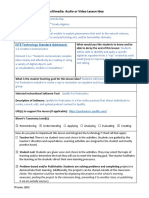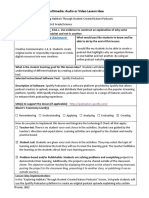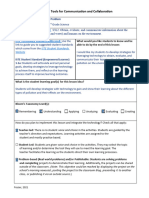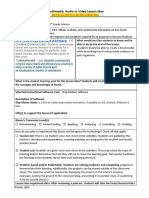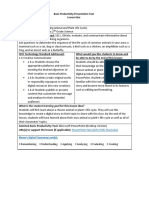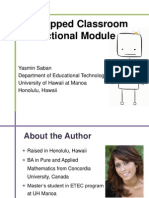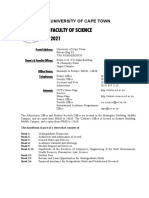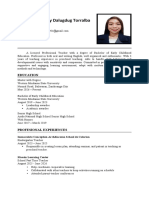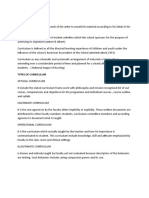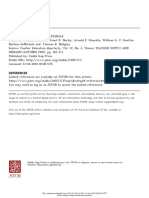Professional Documents
Culture Documents
Learning Sequence
Learning Sequence
Uploaded by
api-2637039130 ratings0% found this document useful (0 votes)
33 views3 pagesOriginal Title
learning sequence
Copyright
© © All Rights Reserved
Available Formats
DOCX, PDF, TXT or read online from Scribd
Share this document
Did you find this document useful?
Is this content inappropriate?
Report this DocumentCopyright:
© All Rights Reserved
Available Formats
Download as DOCX, PDF, TXT or read online from Scribd
Download as docx, pdf, or txt
0 ratings0% found this document useful (0 votes)
33 views3 pagesLearning Sequence
Learning Sequence
Uploaded by
api-263703913Copyright:
© All Rights Reserved
Available Formats
Download as DOCX, PDF, TXT or read online from Scribd
Download as docx, pdf, or txt
You are on page 1of 3
Beginning Learning Experience: Lesson 1
Curriculum Links Student Activities Assessment ICT Resources Teacher Notes
Year 4 Australian
Science Curriculum:
Students explore and
discuss the loss of
habitat of living
things.
Students represent
and communicate
ideas and findings in
a variety of ways.
Students are introduced to
the problem via Glogster.
This resource is prepared by
the school to advertise the
problem. Learners watch a
video recorded by the
principal that reinforces and
encourages their
involvement in the creation
of the campaigns.
The teacher assigns
students to groups, allowing
three to four learners per
group (low/high ability
students). Within their
groups, students consider
what they know and what
they want to find out about
the topic. Students use
Bubbl Us to record their
current knowledge and
understanding.
The teacher assist student
groups to establish a Wiki
Page for their group (explicit
instruction). Clearly outlines
rules and expectations that
encourage safe, legal ethical
online practices.
Formative assessment:
Students ability to design
and edit a Wiki Page to
organise their thinking
and understanding of the
topic.
Check for understanding:
Students effectively
create a mind map using
Bubbl Us to communicate
their current knowledge
about the topic and what
they want to know.
Glogster
http://edu.glogster.com/
Interactive Whiteboard-
play the video through
media player
Bubbl Us
https://bubbl.us/
Wikispaces
http://www.wikispaces.com/
The problem created appeals
to student interests and
abilities. The guided tour via
Glogster, the video file from
the principal and scaffolded
design instructions for the Wiki
Page provides students with a
realistic and authentic problem
solving learning environment.
This problem bridges the gap
between the classroom and
the real world.
It is essential that the teacher
enables students to complete
their mind maps without the
support from the teacher.
Scaffold instructions to inform
the creation of the wiki page;
however allow students to
organise and select their
design layout independently.
Many students identify as
kinesthetic and visual learners.
This learning experience
incorporates a range of hands
on, practical and visual
activities that support student
learning.
Middle Learning Experience: Lesson 3
Curriculum Links Student Activities Assessment ICT Resources Teacher Notes
Year 4 Australian
Science Curriculum:
Students explore and
discuss the loss of
habitat of living
things.
Students represent
and communicate
ideas and findings in
a variety of ways.
Students pose
questions for
investigation.
General Capabilities:
Literacy, Creative and
Critical thinking.
Students review the problem and
possible solutions created in the
previous learning experience. Each
student group orally presents their
possible solutions to the class and
teacher. After listening to their peers
possible solutions, students pose
questions to discover more
information about the topic. Students
collate their groups questions using
Prezi.
Learners have the opportunity to
video conference with their local
RSPCA through Skype. Using the
questions each group created using
Prezi, students have the privilege to
have their questions answered by the
RSPCA.
Students use new information
gathered from the RSPCA and the
class presentation to generate their
draft solution that will solve the
problem. Learners communicate
their ideas on a butchers paper.
Once all group members agree with
the final solution, students will create
a Voki avatar to present to the class.
Formative:
Students ability to
effectively, clearly
and orally
communicate
solutions and
questions to an
audience.
Check to
understanding:
Students are able to
independently
create a Prezi and
Voki.
Prezi
http://prezi.com/
Skype
http://www.skype.com/
Voki
http://www.voki.com/
Class presentations enable
students to share their ideas
and develop communication
skills. Presenting their
possible solutions to their
peers allows students to
ensure they are working
towards the intended
learning outcome. Students
are able to compare their
ideas with others to extend
their understanding of the
topic.
Many students identify as
kinesthetic, auditory and
visual learners. This learning
experience incorporates a
range of hands on, practical,
audio and visual activities
that support student learning.
Video conferencing exposes
students to a range of new
technology devices (refer to
learner profile) and
emphasises the authenticity
of the problem and topic.
Concluding Learning Experience: Lesson 7
Curriculum Links Student Activities Assessment ICT Resources Teacher Notes
Year 4 Australian
Science Curriculum:
Students explore and
discuss the loss of
habitat of living
things.
Students represent
and communicate
ideas and findings in
a variety of ways.
General Capabilities:
Sustainability,
Literacy, Information
Technology
Learners are provided with
10-15 minutes rehearsal
time.
Members from the local
RSPCA and the school
community
(parents/guardians,
principal) arrive to listen to
the campaigns.
Each student group
presents their campaign.
After the meeting, the
classroom teacher and
students reflect on the
topic/unit of work. Use
Bubbl Us to brainstorm key
concepts, interesting
points and fun facts. Print
an A3 copy of the mind
map to display in the
classroom, along with each
groups campaign poster.
Summative Assessment:
Students ability to
effectively, clearly and orally
communicate their
campaign to an audience.
Students incorporate all of
the features of a campaign.
Each groups campaign
addresses they topic and
provides an authentic
solution.
Check for learning: Learners
are able to reflect on the unit
of work and recall what they
learnt, the interesting points
and fun facts.
Bubbl Us
https://bubbl.us/
Students have
previously
communicated to an
audience.
When using Bubbl Us,
allow students to
move up to the front of
the class to write an
idea/concept in each
bubble. Learning
should be student
centred- moving to
share ideas will
stimulate and re-
position students
frequently (ADHD
student).
Many students identify
as kinesthetic,
auditory and visual
learners. Bubbl Us
incorporates a range
of hands on, practical,
audio and visual
activities that support
student learning.
You might also like
- Reading Assessment and Instruction For All LearnersDocument592 pagesReading Assessment and Instruction For All Learnersmariluz cornelio pichoNo ratings yet
- Semi-Detailed Lesson Plan in TLE 8-Beauty Care (Nail Care)Document3 pagesSemi-Detailed Lesson Plan in TLE 8-Beauty Care (Nail Care)Francis Joseph Del Espiritu Santo80% (15)
- How We Express Ourselves Newsletter EnglishDocument3 pagesHow We Express Ourselves Newsletter Englishapi-269131865100% (1)
- NG - Web 2Document2 pagesNG - Web 2api-652952928No ratings yet
- Multimedia Lesson IdeaDocument3 pagesMultimedia Lesson Ideaapi-652775487No ratings yet
- 5th Grade Lesson Plan ElaDocument3 pages5th Grade Lesson Plan Elaapi-674537318No ratings yet
- Web 2Document3 pagesWeb 2api-653292818No ratings yet
- Multimedia Audio or Video LessonDocument2 pagesMultimedia Audio or Video Lessonapi-653325112No ratings yet
- Multimedia Audio or Video Lesson Idea Template2022Document3 pagesMultimedia Audio or Video Lesson Idea Template2022api-689979439No ratings yet
- Harriet Amihere Multimedia Audio or Video Lesson Idea Template2022Document3 pagesHarriet Amihere Multimedia Audio or Video Lesson Idea Template2022api-674932502No ratings yet
- Draft Engaged Learning Project B. Walsh: Improve Creativity in Our School AP English Language 10 GradeDocument6 pagesDraft Engaged Learning Project B. Walsh: Improve Creativity in Our School AP English Language 10 Gradeapi-509386272No ratings yet
- Multimedia Audio or Video Lesson Idea Template2022Document2 pagesMultimedia Audio or Video Lesson Idea Template2022api-679387958No ratings yet
- Unit OverviewDocument3 pagesUnit Overviewapi-263703913No ratings yet
- Itec 3100 m11 Multimedia Video Lesson Idea - Emma StallDocument3 pagesItec 3100 m11 Multimedia Video Lesson Idea - Emma Stallapi-553761170No ratings yet
- Multimedia Audio or Video Lesson Idea Template2022Document3 pagesMultimedia Audio or Video Lesson Idea Template2022api-678572474No ratings yet
- Multimedia Audio Lesson IdeaDocument4 pagesMultimedia Audio Lesson Ideajoceleste16No ratings yet
- Multimedia Audio or Video Lesson Idea HedeDocument2 pagesMultimedia Audio or Video Lesson Idea Hedeapi-618976724No ratings yet
- Web 2.0 Communcation and CollaborationTools) LESSON IDEA TEMPLATEDocument4 pagesWeb 2.0 Communcation and CollaborationTools) LESSON IDEA TEMPLATEjoceleste16No ratings yet
- Basic ProductivityDocument3 pagesBasic Productivityapi-690389338No ratings yet
- Web 2Document3 pagesWeb 2api-724422561No ratings yet
- Lesson 4aDocument5 pagesLesson 4aapi-218476346No ratings yet
- Season 1st Grade Lesson PlanDocument2 pagesSeason 1st Grade Lesson Planapi-674537318No ratings yet
- Itech Lesson 1Document4 pagesItech Lesson 1api-654275072No ratings yet
- Bpts Basic Productivity Tools Lesson Idea TemplateDocument3 pagesBpts Basic Productivity Tools Lesson Idea Templateapi-725888540No ratings yet
- Multimedia Audio or Video Lesson Idea Template2022Document2 pagesMultimedia Audio or Video Lesson Idea Template2022api-693890981No ratings yet
- MultimediaDocument3 pagesMultimediaapi-675603419No ratings yet
- Bpts Basic Productivity Tools Lesson Idea TemplateDocument3 pagesBpts Basic Productivity Tools Lesson Idea Templateapi-690026845No ratings yet
- Web 2Document2 pagesWeb 2api-631396855No ratings yet
- Multimedia Lesson Idea Cole WilsonDocument2 pagesMultimedia Lesson Idea Cole Wilsonapi-675370345No ratings yet
- Multimedia Audio or Video Lesson IdeaDocument2 pagesMultimedia Audio or Video Lesson Ideaapi-652816243No ratings yet
- Multimedia Audio or Video Lesson Idea Template2022Document2 pagesMultimedia Audio or Video Lesson Idea Template2022api-653326359No ratings yet
- Audio Lesson - Itec 3100Document3 pagesAudio Lesson - Itec 3100api-653282837No ratings yet
- Bpts Basic Productivity Tools-Erin IsbellDocument2 pagesBpts Basic Productivity Tools-Erin Isbellapi-724175639No ratings yet
- Bpts Basic Productivity Tools Lesson Idea TemplateDocument2 pagesBpts Basic Productivity Tools Lesson Idea Templateapi-653299169No ratings yet
- Multimedia Audio or Video Lesson Idea Template2022 1Document3 pagesMultimedia Audio or Video Lesson Idea Template2022 1api-728263587No ratings yet
- Final Multimedia Audio or Video Lesson Idea Template2022Document2 pagesFinal Multimedia Audio or Video Lesson Idea Template2022api-631555971No ratings yet
- Bpts Basic Productivity Tools Lesson Idea LilianavDocument3 pagesBpts Basic Productivity Tools Lesson Idea Lilianavapi-724028621No ratings yet
- Multimedia Audio or Video Lesson Idea Template2022Document4 pagesMultimedia Audio or Video Lesson Idea Template2022api-675327927No ratings yet
- Multimedia Audio or Video Lesson Idea Template2022Document3 pagesMultimedia Audio or Video Lesson Idea Template2022api-675099340No ratings yet
- Lesson Plan AudioDocument2 pagesLesson Plan Audioapi-631538064No ratings yet
- Basic Productivity Tools LessonDocument2 pagesBasic Productivity Tools Lessonapi-517070198No ratings yet
- Web 2Document3 pagesWeb 2api-727669937No ratings yet
- BBPTDocument2 pagesBBPTapi-445312066No ratings yet
- L15 Prefinal Project Based Learning and MultimediaDocument35 pagesL15 Prefinal Project Based Learning and MultimediaRochelle Anne SorioNo ratings yet
- Itec 3100 - Basic Productivity Tool Lesson PlanDocument3 pagesItec 3100 - Basic Productivity Tool Lesson Planapi-733331222No ratings yet
- Multimedia Audio or Video Lesson Idea Template2022Document2 pagesMultimedia Audio or Video Lesson Idea Template2022api-727669937No ratings yet
- PollutionDocument1 pagePollutionapi-523863338No ratings yet
- Forward Planning Document: School of EducationDocument5 pagesForward Planning Document: School of Educationapi-346233733No ratings yet
- Web 2Document2 pagesWeb 2api-691891491No ratings yet
- Web 2Document2 pagesWeb 2api-631425357No ratings yet
- Project Based LearningDocument17 pagesProject Based LearningClaudita MosqueraNo ratings yet
- Multimedia Audio or Video Lesson Idea LizDocument2 pagesMultimedia Audio or Video Lesson Idea Lizapi-675585354No ratings yet
- MultimediaDocument2 pagesMultimediaapi-724708449No ratings yet
- Multimedia Video Lesson Plan FinalDocument2 pagesMultimedia Video Lesson Plan Finalapi-631396855No ratings yet
- BPTs Basic Productivity Tools LESSON IDEA TemplateDocument3 pagesBPTs Basic Productivity Tools LESSON IDEA Templatemadisonkg777No ratings yet
- Description of Exhibition OrganizationDocument4 pagesDescription of Exhibition Organizationapi-353859154No ratings yet
- BPTs Basic Productivity Tools LESSON IDEA TemplateDocument4 pagesBPTs Basic Productivity Tools LESSON IDEA TemplatemwhidbyNo ratings yet
- Multimedia Audio or Video 2022 Phoebe BunnyDocument3 pagesMultimedia Audio or Video 2022 Phoebe Bunnyapi-631778130No ratings yet
- Lesson Plan - WeeblyDocument3 pagesLesson Plan - Weeblyapi-675099340No ratings yet
- Completed-Multimedia Audio or Video Lesson Idea Template2022Document2 pagesCompleted-Multimedia Audio or Video Lesson Idea Template2022api-631448157No ratings yet
- Beyond The Basics Lesson Plan G MihelickDocument2 pagesBeyond The Basics Lesson Plan G Mihelickapi-572368926No ratings yet
- Audio Lesson PlanDocument3 pagesAudio Lesson Planapi-618844521No ratings yet
- Yasmin Saban TCC Presentation SlidesDocument36 pagesYasmin Saban TCC Presentation Slidesapi-218666455No ratings yet
- Curriculum Evaluation Final3Document41 pagesCurriculum Evaluation Final3Mrz DordasNo ratings yet
- New & Revised Curriclum Presentation (Draft) .10.9.23Document18 pagesNew & Revised Curriclum Presentation (Draft) .10.9.23LehighValley NewsdotcomNo ratings yet
- CV WeeblyDocument2 pagesCV Weeblyapi-403424876No ratings yet
- 250c SyllabusDocument7 pages250c Syllabusdavisfc50No ratings yet
- President Joe Biden's Stimulus PlanDocument19 pagesPresident Joe Biden's Stimulus PlanThe College FixNo ratings yet
- Scheme of Examination Total Marks: 100 Theory: 80 Internal Assessment: 20 Time: 3 HrsDocument1 pageScheme of Examination Total Marks: 100 Theory: 80 Internal Assessment: 20 Time: 3 HrsHemlata BatnagarNo ratings yet
- CV of Bipul DhaliDocument2 pagesCV of Bipul DhaliGEAR Travel LtdNo ratings yet
- Sgc-Resolution No. 03Document2 pagesSgc-Resolution No. 03Carol LaconsayNo ratings yet
- 2021 SCI HandbookDocument249 pages2021 SCI HandbookCcenay GodfreyNo ratings yet
- ProspectusDocument18 pagesProspectusRowan Tree PrimaryNo ratings yet
- Curriculum VitaeDocument3 pagesCurriculum VitaeMaria Christine Joy TorralbaNo ratings yet
- Learning Skills Assessment RubricDocument2 pagesLearning Skills Assessment Rubric58926No ratings yet
- Curriculum Curriculum DevelopmentDocument19 pagesCurriculum Curriculum DevelopmentJeenagg Narayan50% (2)
- SEL: Organ Donation Lesson PlanDocument3 pagesSEL: Organ Donation Lesson PlanNur Ain Mohd Amin67% (3)
- Reading Worksheet Daily ActivitiesDocument2 pagesReading Worksheet Daily Activitiesun chico llamado kaidesNo ratings yet
- Metacognitive Analogy IntructionDocument21 pagesMetacognitive Analogy IntructionPat BitaraNo ratings yet
- The Emergence of Entrepreneurship Education: Development, Trends, and ChallengesDocument21 pagesThe Emergence of Entrepreneurship Education: Development, Trends, and ChallengesIcha WijayantiNo ratings yet
- Edited Bestari Business PlanDocument26 pagesEdited Bestari Business PlanJohn SonNo ratings yet
- Caddo Gap Press Teacher Education Quarterly: This Content Downloaded From 152.118.24.10 On Thu, 12 Apr 2018 05:00:56 UTCDocument6 pagesCaddo Gap Press Teacher Education Quarterly: This Content Downloaded From 152.118.24.10 On Thu, 12 Apr 2018 05:00:56 UTCNon AisahNo ratings yet
- Student'S Guide For Final Year Project Thesis: BSC, MSC, Ma, and MbaDocument16 pagesStudent'S Guide For Final Year Project Thesis: BSC, MSC, Ma, and MbaNguyên Nguyễn0% (1)
- Accomplishment Report - Mtb-Mle (Sy 2020-2021)Document3 pagesAccomplishment Report - Mtb-Mle (Sy 2020-2021)Erika Ikang Wayaway100% (2)
- Altis Abm Review Format - TN Altis - July ' 2022Document39 pagesAltis Abm Review Format - TN Altis - July ' 2022thiru557No ratings yet
- Assessment Brief - Planning Your Career in Business (V-3)Document3 pagesAssessment Brief - Planning Your Career in Business (V-3)Alvi SiddiqueNo ratings yet
- Benefits of Fiction That Will Probably Surprise You!!Document2 pagesBenefits of Fiction That Will Probably Surprise You!!Stuart NewtonNo ratings yet
- Plan For CourseDocument3 pagesPlan For CourseMuhammad Daud SaleemiNo ratings yet
- Improve Students' Recount Text Writing Ability at TheDocument81 pagesImprove Students' Recount Text Writing Ability at ThemonicaNo ratings yet











